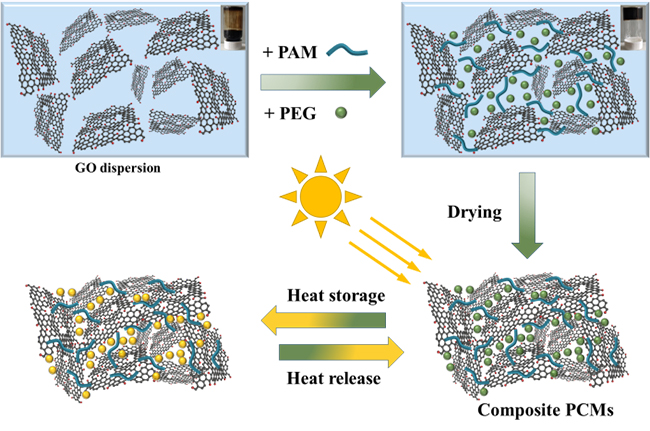Researchers Propose One-step Strategy to Synthesize Graphene-based Composite Phase Change Materials
Graphene-based composite phase change materials (PCMs) exhibit great potential in the field of solar-thermal energy conversion and storage.
Current synthesis methods of the graphene-based composite PCMs usually involve multi‐step processes that are generally complicated, time‐ and energy‐consuming, hindering its further practical application especially in large-scale solar-thermal energy utilization.
Recently, Prof. SHI Quan's group from the Dalian Institute of Chemical Physics (DICP) of the Chinese Academy of Sciences (CAS) proposed a facile and straightforward one-step strategy of constructing graphene-based shape-stable PCMs with polyethylene glycol (PEG) in situ filled into a graphene oxide (GO) network structure hydrogel.
This study was published in Chemical Engineering Journal on Sept. 9.

Schematic diagram of the PEG/GO-PAM composite PCMs synthesis (Image by LI Yangeng)
Compared with the currently reported synthetic routes, the complexity, processing time and cost of the synthesis strategy are reduced in this newly proposed strategy.
The as-prepared composite PCMs showed a high PEG loading capacity up to 95 wt.%, and could maintain a relatively constant phase change enthalpy of 162.8 J/g even after 1000 phase transition cycles.
The composites also exhibited excellent solar-thermal energy conversion ability, which could quickly convert solar energy into thermal energy and store it in the PCMs with a conversion efficiency of up to 93.7%.
This work provides a new idea for large-scale preparation of graphene-based solar-thermal conversion composite PCMs.
The above work was supported by Joint Fund of the Yulin University and Dalian National Laboratory for Clean Energy, National Nature Science Foundation of China and Dalian Institute of Chemical Physics. (Text by LI Yangeng)